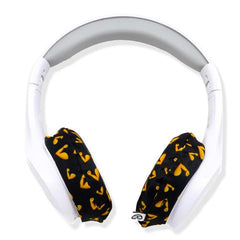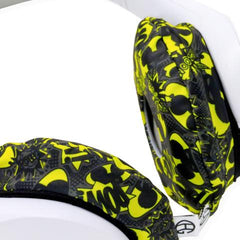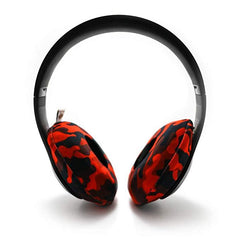Why do headphones stop working?

It’s frustrating when you’ve paid good money for a pair of headphones and they end up breaking. You might expect it from models that cost £30 or $30 but what about premium brands like Beats or Bose?
Related: Beats headphones: why is the leather peeling?
Why are my Bose Headphone Ear Pads Falling Apart?
Headphone protection is pretty limited and because we wear them on our heads (and many of us are wearing them wired), they’re pretty vulnerable pieces of kit.
But is it unfair to blame build quality? Does the fault lie with the manufacturer or with the wearer? Have we all become so complacent with technology that we expect to be able to treat things carelessly and still keep them working?
And for every person you know who’ll agree with you that headphones are made to break, you’ll find some wizened old audiophile still wearing the pair he first bought back in the 1970s.
Should we take more responsibility not only for the way we wear our headphones but also for the amount we’re willing to pay? Cheaper headphones mean cheaper build quality, after all. If people are still wearing Sennheiser’s from back before you were born, then maybe they were right to invest more initially to save a lot more in the long run? How long should a £50 or £500 pair of headphones last?
But finding headphone protection is easier said than done.
To us, it’s a pair of sweat-proof headphone covers and keeping the cushions away from direct sunlight. We’re as bad as anyone for throwing them into sports bags, gym lockers or wrapping the wires incorrectly. You only have to look at the number of people with cracked iPhone screens to know that most of us are pretty complacent when it comes to looking after our technology, but maybe if we have some understanding of why they’re not working, we’ll be able to keep our headphones working for longer.
So, what are some of the more common reasons for headphones to stop working?
Your headphone cable can make your headphone stop working
The biggest problem area on most headphones is the cable. The internal copper wires are thin, delicate and pretty easy to damage. If you’ve ever had wired earphones, then you’ll appreciate how easy it is to lose sound in one or both speakers.
Headphones are harder-wearing but the weak spot is the same. Part of the problem with the cable is that we can’t see the damage we’re doing when we incorrectly wrap the wires or when we roll over them with desk chairs or catch them on door handles. Often the damage is done incrementally but sometimes, with another force or weight, you can wreak them with a single event.
Unless you have the expertise to fix them or to solder the wires, you’re going to be stuck with popping or crackling in the speakers or a completely dead speaker.
Being careful with the cord should help improve the longevity of your headphones. You should look for headphones with a stronger or braided cable. This will give additional protection to the internal wires. Some manufacturers include a removable cable for wired cans which offers an easy form of headphone protection when you’re not using them.
You should be careful with how you remove your wire from your device, too, and look for elbow jacks. Make sure that you’re not pulling on the cord when you need to remove it as this can weaken the wire inside.
Wired headphones can be difficult to protect because many of us wear them for escapism: we’re gaming with them or watching a film or listening to music and it’s easy to forget we’re still wearing them.
We’ve probably all done it – stood up abruptly, forgetting we’re still plugged in and trying to walk away. The cable pulls out of the headphones and we have that ‘uh-oh’ moment.
There’s no easy advice for this other than to take more care. Be careful walking through doorways, too, as they can snag wires. And don’t fall asleep in headphones as pushing the wire into awkward positions can bend the wire unnaturally.
Using a case for headphone protection
We all know we should store our headphones correctly, but few of us do it. It may be one reason why your headphones aren’t lasting as long as they should. It’s easy to be complacent about this even if you’re only using your headphones at home.
The carry case can help protect against damage to the headband and the earcups during travelling or when you’re moving about. It also protects the headphone from dust damage and UV light which is incredibly important if you have white headphone covers. The case it arrived in might not be suitable for your lifestyle or needs, so it’s worth shopping around for a better sort. In some cases, you may need a hard-shell case. Cases have come a long way in recent years, and a good-looking headphone will be complimented hugely by a smart carry case or bag.
Wearing EarHugz as Headphone Protectors
Headphone protectors aren’t just needed for the cables or headbands, either. Moisture damage can be a big problem for gamers or anyone regularly working out in their headphones. Moisture inside the internal components of any electrical device is bad news, but it’s a two-pronged problem because sweat can also discolour and distress the cushions of your headphone and whilst that won’t necessarily break them outright it will affect the way you wear them, their fit and they’ll smell pretty bad, too. You don’t want any reason to have to throw out your headphones before their time.


Manufacturing Defects
There also has to be some blame laid at the door of manufacturers. People are complaining that the lifespan even of premium brands is getting smaller and this could be because they’re using cheaper materials or that they’re favouring design over durability. Unfortunately, this compromise isn’t always reflected in the price.
Beats has been criticised in the past for using cheaper components in its headphones and then ramping the price up.
We’d suggest that anyone buying headphones does thorough research especially if it’s a bigger price point. Often the best advise is on forums where people who are passionate about these products will give an honest review. You should also think about what you’re using the headphones for and buy according to what’s best for your lifestyle.



